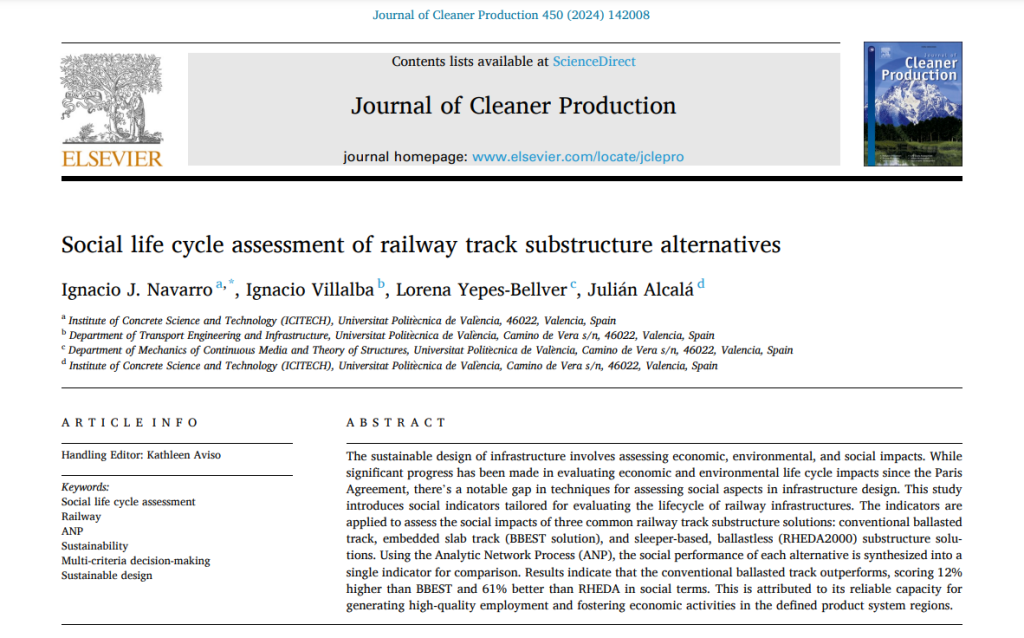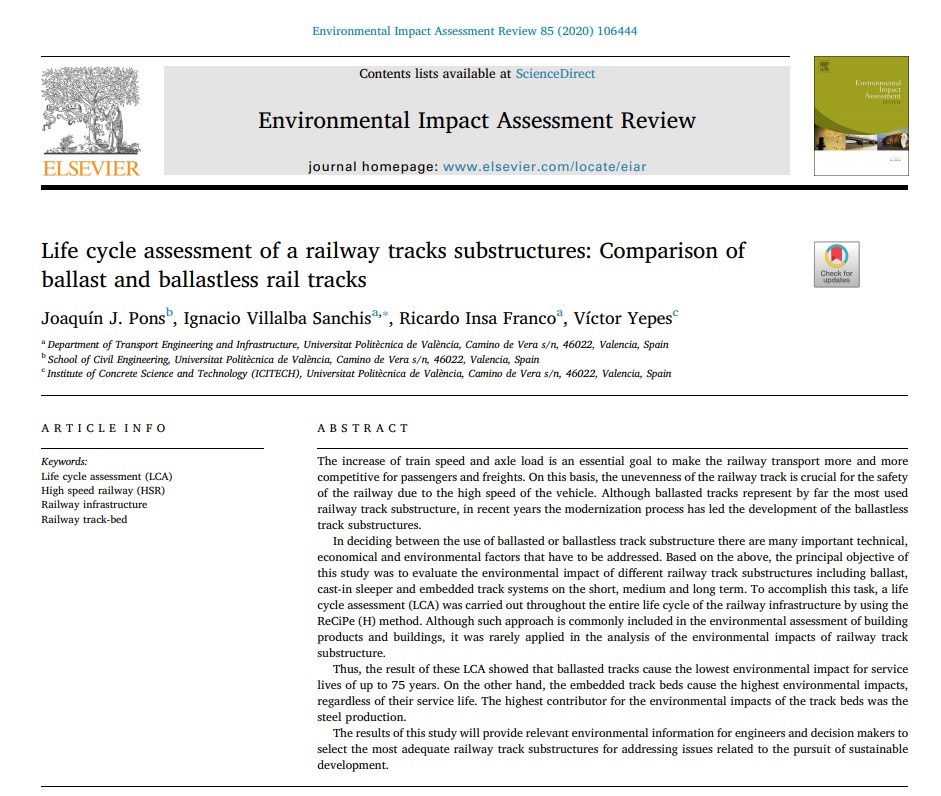 Acaban de publicar un artículo en el Journal of Cleaner Production, revista indexada en el primer decil del JCR. El estudio presenta indicadores sociales diseñados para evaluar el ciclo de vida de las infraestructuras ferroviarias y evalúa los impactos sociales de tres soluciones comunes de este tipo subestructura. La investigación tiene como objetivo determinar la alternativa de diseño más ventajosa desde el punto de vista social para la infraestructura ferroviaria, haciendo hincapié en la importancia de tener en cuenta los factores sociales junto con las dimensiones económicas y ambientales en el desarrollo sostenible. El trabajo se enmarca dentro del proyecto de investigación HYDELIFE que dirijo como investigador principal en la Universitat Politècnica de València.
Acaban de publicar un artículo en el Journal of Cleaner Production, revista indexada en el primer decil del JCR. El estudio presenta indicadores sociales diseñados para evaluar el ciclo de vida de las infraestructuras ferroviarias y evalúa los impactos sociales de tres soluciones comunes de este tipo subestructura. La investigación tiene como objetivo determinar la alternativa de diseño más ventajosa desde el punto de vista social para la infraestructura ferroviaria, haciendo hincapié en la importancia de tener en cuenta los factores sociales junto con las dimensiones económicas y ambientales en el desarrollo sostenible. El trabajo se enmarca dentro del proyecto de investigación HYDELIFE que dirijo como investigador principal en la Universitat Politècnica de València.
El estudio utilizó el proceso de redes analíticas (ANP) para sintetizar el desempeño social de las diferentes soluciones de subestructuras en un solo indicador de comparación. La investigación recopiló datos de inventario de las bases de datos oficiales del territorio español para evaluar los indicadores basados en el contexto social. El documento estableció una colección de criterios mensurables y seleccionó seis indicadores sociales basándose en las «directrices» y las fichas metodológicas para las subcategorías de la evaluación del ciclo de vida social. La metodología introducida en la investigación se puede aplicar en la evaluación de los impactos sociales en varios proyectos de infraestructura más allá de los ferrocarriles, como puentes, carreteras o estructuras portuarias, lo que mejora la aplicabilidad de la evaluación del ciclo de vida social.
Las contribuciones más destacables de este trabajo son las siguientes:
- Introduce indicadores sociales diseñados para evaluar el ciclo de vida de las infraestructuras ferroviarias.
- Evalúa los impactos sociales de tres soluciones frecuentes de subestructura de vías férreas.
- Destaca la importancia de considerar los factores sociales junto con las dimensiones económicas y ambientales en el desarrollo de infraestructuras sostenibles.
ABSTRACT
The sustainable design of infrastructure involves assessing economic, environmental, and social impacts. While significant progress has been made in evaluating economic and environmental life cycle impacts since the Paris Agreement, there’s a notable gap in techniques for assessing social aspects in infrastructure design. This study introduces social indicators tailored for evaluating the lifecycle of railway infrastructures. The indicators are applied to assess the social impacts of three common railway track substructure solutions: conventional ballasted track, embedded slab track (BBEST solution), and sleeper-based, ballastless (RHEDA2000) substructure solutions. Using the Analytic Network Process (ANP), the social performance of each alternative is synthesized into a single indicator for comparison. Results indicate that the conventional ballasted track outperforms, scoring 12% higher than BBEST and 61% better than RHEDA in social terms. This is attributed to its reliable capacity for generating high-quality employment and fostering economic activities in the defined product system regions.
KEYWORDS:
Social life cycle assessment; Railway; ANP; Sustainability; Multi-criteria decision-making; Sustainable design.
REFERENCE:
NAVARRO, I.J.; VILLALBA, I.; YEPES-BELLVER, L.; ALCALÁ, J. (2024). Social life cycle assessment of railway track substructure alternatives. Journal of Cleaner Production, 450:142008. https://doi.org/10.1016/j.jclepro.2024.142008.
Os dejo el artículo para su descarga, pues está publicado en abierto.

